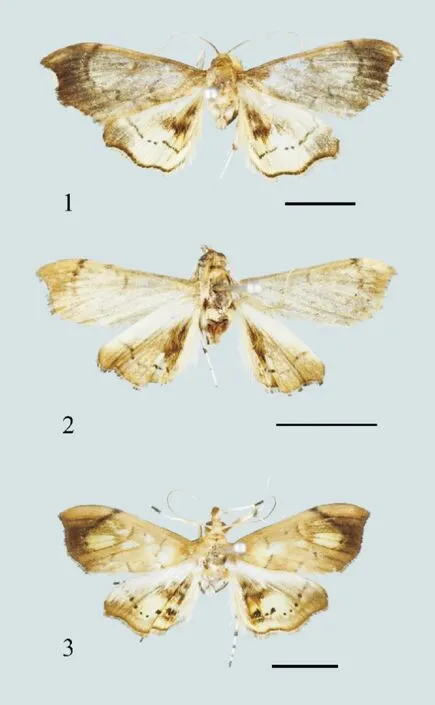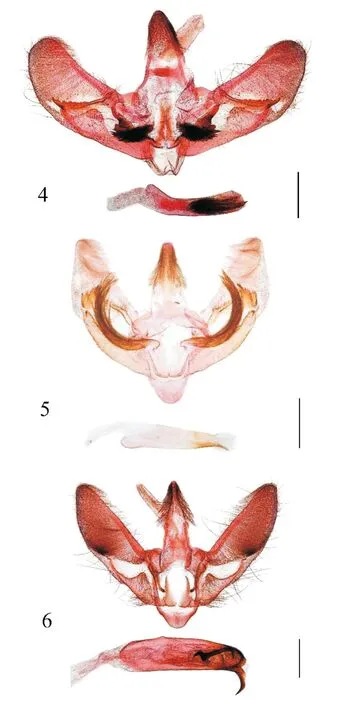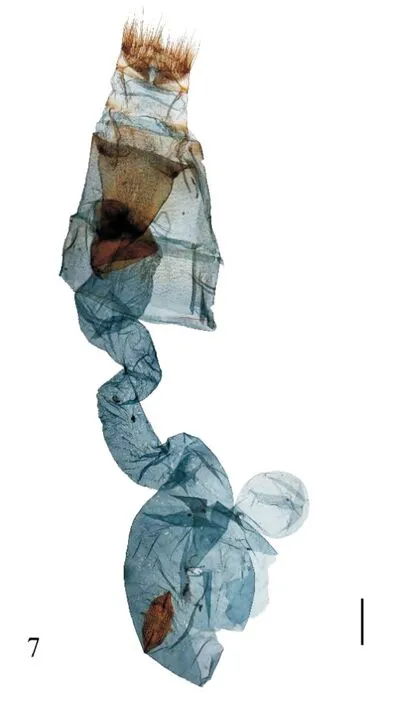Taxonomic notes on the genus Discothyris Warren, 1895 (Lepidoptera: Crambidae, Pyraustinae)
2023-11-09GUOMuYuCHENKaiZHANGDanDanSchoolofEcologySunYatsenUniversityShenzhen58000GuangdongProvinceChinaSchoolofLifeSciencesSunYatsenUniversityGuangzhou5075China
GUO Mu-Yu, CHEN Kai, ZHANG Dan-Dan* (. School of Ecology, Sun Yat-sen University, Shenzhen 58000, Guangdong Province, China; . School of Life Sciences, Sun Yat-sen University, Guangzhou 5075, China)
Abstract:The genus Discothyris is confirmed belong to Pyraustinae based on the genitalic characters. The genus and its three species are redescribed. D. vestigialis (Snellen, 1890) is newly recorded from China. Photographs of adults and genitalia are offered. A key to species is given.
Key words:Lepidoptera; Crambidae; Pyraustinae; Discothyris; newly recorded species of China
Introduction
Warren (1895) erected the genusDiscothyrisin Pyraustinae (s.lat.) for two speciesAgroteraferruginataMoore, 1888 from Darjeeling andGonocaustavestigialisSnellen, 1890 from Sikkim, and designatedAgroteraferruginataas type species. Later, Hampson (1899) reportedDiscothyrismegalophalisfrom Khasi Hills. Currently only three species are known from India and Southern China. They can be easily recognized in appearance by the falcate apex and bulged termen of wings, sometimes semitransparent patches of forewing, a bundle of hairy scales present posterior of cell of hindwing. OnlyD.vestigialisis found with some frequency. The other two species are very infrequently encountered. Thus, this small genus is little known.
Minet (1982) split Spilomelinae from Pyraustinae because he considered that Spilomelinae lack convincing diagnostic features as in Pyraustinae (s.str.): sella on the inner surface of the valva, often with strong piliform or spatulate hairs in male genitalia, the appendix bursae emerging from the anterior ductus bursae, and the distinctive rhombical signum in female genitalia (Munroe, 1976). And the genusDiscothyrisis placed in subfamily Spilomelinae (Nussetal., 2022) for now. In this study, genitalic morphology of type material and specimens collected from southern China indicate this genus belong to Pyraustinae. The genus is redescribed below.
Material and methods
In this study, light-trapping was used to collect specimens.Slides of genitalic dissections referred to Robinson (1976) and Li &Zheng (1996), with some modifications. Genitalia terminology followed Klots (1970) and Kristensen (2003). Images of the adults were taken by a Canon EOS 60D camera provided with a Canon 100 mm macro lens; the genitalia pictures were taken using Zeiss Axio Scope. A1 in combination with a Zeiss AxioCam camera and the Axio Vision SE64 programme on a Windows PC; source images were then aligned and stacked on Helicon Focus to obtain a fully sharpened composite image.
The specimens studied are deposited in the Museum of Biology, Sun Yat-sen University, Guangzhou, China (SYSBM), except for those held at the following institutions: Natural History Museum, London, United Kingdom (NHMUK) and Insect Collection of the College of Life Sciences, Nankai University, China (NKU).
Taxonomy
DiscothyrisWarren,1895
DiscothyrisWarren, 1895 ∶473.
Typespecies:AgroteraferruginataMoore, 1888, by original designation.
Diagnosis.Discothyriscan be recognized by the somewhat falcate apex and bulged termen of wings, patches of hairy scales posterior of cell of hindwing in appearance, by the divided juxta, the ventral projection extending from costal base of valva covered with setae or minute denticules. This genus is closely related toPlacosarisMeyrick, 1897, sharing the lateral sclerotized area of the phallus bearing a spine, can be distinguished from the latter by the above-mentioned characters, as well as by the nearly triangular uncus, absent the elongate dorsal sella with an inflated and densely setose apex.
Redescripiton.Head.Frons round, smoothly scaled. Vertex with moderately raised scales projecting between antennae. Labial palpus obliquely porrect; approximately twice as long as diameter of eye. Maxillary palpus small, filiform. Proboscis well developed, with slightly yellow scales at base. Antenna with cilia in male.Thorax.Dorsal side greyish brown; ventral side whitish to pale yellow. Legs unmodified usually, outer spur 1/2 the length of inner spur. Forewing elongate-triangular, costa straight to near apex, then slightly arched to apex; apex somewhat falcate; termen medially bulged; dorsum straight. Hindwing broad, fan-shaped; with apex and termen similar to forewing. Wings usually greyish brown or blackish brown; forewing sometimes with scaleless and partially semitransparent patches posterior and outside of cell; hindwing with patches of hairy scales surrounded by brown scales on anal area.Abdomen.Dorsal side greyish brown; ventral side whitish to pale yellow.Malegenitalia.Uncus nearly triangular; laterally densely covered with simple setae and dorsally covered with setae divided into two lobes nearly apex. Transtilla small. Valva elongated tongue-shaped, costa straight to slightly concave and ventral margin bulged; costal base extending a ventral projection cover with long setae or minute denticules; sella irregular; sacculus sclerotized. Juxta divided into two lobes. Saccus broad and round. Phallus tubular, with apex sclerotized laterally and bearing a process.Femalegenitalia.Ovipositor lobes densely setose. Anterior apophysis usually ~2.0× length of posterior apophysis. Lamella antevaginalis composed by a pair of falcate sclerites. Antrum tube-shaped, weakly sclerotized, densely spinulose except marginal area; ductus bursae ~2.0× length of corpus bursae spiral, stout and wrinkled, posterior part with a large and strong sclerite, corpus bursae oval and wrinkled, appendix bursae arising from posterior part of corpus bursae; signum nearly rhombic, strongly sclerotized and bearing spines.
Distribution.Southern China, India.
KeytospeciesofDiscothyrisbasedonmales
1 Forewing length more than 10.0 mm; ventral projection of costal base bearing short and straight setae or minute denticules
2
Forewing length 8.0 mm; ventral projection of costal base bearing a cluster of long and curved setae extending beyond dorsal margin of valva
D.megalophalis
2 Forewing with light yellow spots between M2and CuA1inside of postmedial line; present a gnathos; the ventral projection of costal base bearing minute denticules; basal half of sacculus with a nearly triangular protrusion; phallus with apex bearing a strong spine extended vertically
D.vestigialis
3 Forewing without light yellow spots; ventral projection of costal base bearing short and straight setae; distal half of sacculus with a nearly domed protrusion; phallus with apex bearing a minute spine
D.ferruginata
Discothyrisferruginata(Moore,1888)
Figs 1, 4
AgroteraferruginataMoore, 1888 ∶209.
Discothyrisferruginata: Warren, 1895 ∶474.
Diagnosis.This species can be differentiated from congeners by the blackish brown forewing.D.ferruginatais similar toD.megalophalisin male genitalia, but can be distinguished from the latter by broadly rounded apex of valva, the short and straight setae on thick and sclerotized ventral projection of costal base of valva, the thumb-shaped dorsal sella and narrow and hook-shaped ventral sella, and the nearly domed protrusion on distal half of sacculus.
Redescription(Fig.1). Forewing length 11.0~12.0 mm.Male.Head.Frons and vertex light brown. Labial palpi brown, dirty white at base beneath. Maxillary palpi brown, paler at apex. Basal scales of proboscis slightly yellow. Antennae brown.Thorax.Brown dorsally and greyish yellow ventrally. Foreleg white, femur brown dorsally, tarsomeres dark brown terminally. Midleg and hindleg light yellow, tarsus white. Forewing fuscous, slightly darkened from postmedial line to termen, with markings blackish brown; antemedial line obliquely outwards from basal 1/4 of costa to 1/3 of 1A, then to basal 1/3 of dorsum; reniform stigma short stick-shaped; postmedial line from 3/4 of costa to basal 2/5 of CuA2, then dentated to about 2/3 of dorsum; the area between discocellulars and postmedial line partially semitransparent; fringe blackish brown, partly white. Hindwing pale yellow, with anterior half sparsely scattered with dark brown scales, patches of hairy scales ferruginous and surrounded by blackish brown scales; postmedial line blackish brown, nearly parallel to termen; fringe with basal half blackish brown, and distal half pale yellow, suffused with brownish tinge.Abdomen.Brown dorsally, dirty white ventrally.Malegenitalia(Fig.4). Uncus with a narrowly rounded apex, densely cover with setae. Valva with dorsal margin slightly concave and ventral margin bulged in middle, apex broadly rounded; costal base extending a ventral projection nearly triangular, strongly sclerotized, with distal end densely covered with short setae; sella plate-shaped, with dorsal part thumb-shaped sparsely covered with setae and bearing a small process inside bearing a single seta, with ventral part hook-shaped; sacculus with a domed protrusion on distal half. Juxta composed of a pair of long and slender lobes. Phallus curved, with apex forming a minute spine, distal half with interlaced spines cluster on vesica.

Fig.1~3 Adults of Discothyris spp.

Fig.4-6 Male genitalia of Discothyris spp.
Female.Unknown.
Materialexamined.Holotype♂, no collection label (NHMUK), according to original literature, collected from Darjeeling, India.Othermaterialexamined:China:Yunnan: 1♂, Mt. Gaoligongshan, Baoshan, 24.82°N, 98.78°E, alt. 1 700 m, 22.V.2016, leg. Duan Yongjiang, genitalia slide no. SYSU1027; 1♂, Pianma, Nujiang, 26.01°N, 98.62°E, alt. 1 790 m, 15-16.V.2021, leg. Jin Mengjie, Guo Muyu, Fu Haiyun.
Distribution.China (Yunnan, Taiwan), India.
DiscothyrismegalophalisHampson,1899
Figs 2, 5
DiscothyrismegalophalisHampson, 1899 ∶201.
Diagnosis.This species can be differentiated from congeners by the small bodysize (forewing length 8.0 mm).D.megalophaliscan be distinguished fromD.ferruginatain narrowly rounded apex of valva, the long and upcurved setae on ventral projection of costal base of valva, the slice-shaped dorsal sella and wide, square-shaped ventral sella.
Redescription(Fig.2). Forewing length 8.0 mm.Male.Head.Frons and vertex light brown. Labial palpi brown, slightly yellow at base beneath. Maxillary palpi brown. Basal scales of proboscis dark yellow. Antennae light yellow, basally dark brown.Thorax.Yellowish brown dorsally and light yellow ventrally. Foreleg white, femur and tarsus dark brown. Midleg white, hindleg light yellow, tarsomeres of midleg and hindleg brown distally. Forewing yellowish brown, markings similar toD.ferruginata, absent the semitransparent area; fringe brown, partly white. Hindwing yellowish brown; patches of hairy scales ferruginous and surrounded by brown scales; postmedial line blackish brown, nearly parallel to termen; fringe dark brown, mingled with pale yellow line medially.Abdomen.Yellowish brown dorsally, dirty white ventrally.Malegenitalia(Fig.5). Uncus with lateral margin slightly concave, apex narrowly rounded, densely covered with setae. Valva with dorsal margin nearly straight and ventral margin bulged near apex, apex narrowly rounded; costal base extending a ventral projection, covered with long and upcurved setae extending beyond dorsal margin of valva; sella plate-shaped, with dorsal part slice-shaped and sparsely bearing setae, with ventral part broadly square-shaped, dorsal margin with short spines; sacculus with basal 3/4 slightly inflated. Juxta composed of a pair of wide and short lobes. Phallus relatively straight, gradually slender to apex, with apex forming a slender finger-shaped process along sclerotized margin.
Female.Unknown.
Materialexamined.Holotype♂, Khasis, Oct.1894, Nat. Coll. (NHMUK).Othermaterialexamined:China:Guangdong: 1♂, Heishiding, Fengkai, 2.VIII.2011, Leg. Tong Bo, Li Yun, Xie Jiaqin, genitalia slide no. LJW12100.
Distribution.China (Guangdong), India.
Discothyrisvestigialis(Snellen,1890)
Figs 3, 6, 7
GonocaustavestigialisSnellen, 1890 ∶628.
Discothyrisvestigialis: Warren, 1895 ∶474.
Diagnosis.This species can be differentiated from congeners by the forewing with light yellow spots between M2and CuA1in appearance; in the male genitalia by the narrowest uncus, presence of a gnathos, the slender valva, the ventral projection extended from costal base of valva covered with minute denticules, the finger-shaped dorsal sella and minute ventral sella, the triangular protrusion on basal half of sacculus, as well as the stout spine-shaped cornuti and the strong spine extended vertically from phallus apex.
Redescription(Fig.3). Forewing length 10.0~13.0 mm.Head.Frons and vertex light brown. Labial palpi brown, dirty white at base beneath. Maxillary palpi light brown. Basal scales of proboscis slightly yellow. Antennae brown, with basal part pale yellow and distal part white.Thorax.Yellowish brown dorsally and greyish yellow ventrally. Foreleg brown, tarsus white with distal part blackish brown, femur brown dorsally, tarsomeres dark brown terminally. Midleg brown, with tibia white. Hindleg white, tibia light yellow dorsally, tarsomeres dark brown terminally except the brown last tarsomere. Forewing yellowish brown, darkened on middle part of termen, with markings blackish brown; postmedial line from 1/5 of costa arched to basal 1/3 of dorsum; orbicular stigma dot-shaped, reniform stigma short stick-shaped; with a scaleless and partially semitransparent patch between base of CuA1and CuA2, two light yellow or semitransparent patches circled by M2, CuA1and postmedial line; postmedial line arched from basal 2/3 of costa to half of CuA2, then dentated to 2/3 of dorsum; fringe blackish brown. Hindwing brown, pale yellow in middle, patches of hairy scales pale brown and surrounded by brown scales; postmedial line blackish brown, composed by a series of dots, nearly parallel to termen, inner side followed by blackish brown patches near tornus; fringe brown, with base dark brown.Abdomen.Dark brown dorsally, pale yellow ventrally.Malegenitalia(Fig.6). Uncus with distal half narrow, apex pointed rounded, densely covered with setae. Valva with dorsal margin nearly straight and ventral margin slightly bulged, apex narrowly rounded; costal base extending a ventral projection finger-shaped, moderately sclerotized, with basal 2/3 and distal end densely covered with minute denticules; dorsal sella thumb-shaped, densely covered with setae, ventral sella minute; sacculus with a triangular protrusion on basal half. Juxta composed of a pair of long lobes that gradually slender to the point apex. Phallus strong and straight, vesica with a stout spine-shaped cornuti at distal half, a strong and curved spine extended vertically from phallus apex.Femalegenitalia(Fig.7). As the generic characters.

Fig.7 Female genitalia of Discothyris vestigialis (genitalia slide no. SYSU1677). Scale bar: 0.5 mm.
Materialexamined.China:Hunan: 10♂1♀, Shunhuangshan National Nature Reserve, Xinning, 36.40°N, 111.11°E, alt. 810 m, 4-6.IX.2020, leg. Jin Mengjie, Xiang lanbin;Guangdong: 9♂1♀, Heishiding, Fengkai, 23.47°N, 111.90°E, alt. 214 m, 1.V.2011, 5.IX.2011, 9.VII.2017, leg. Zhang Dandan, Yang Lijun, ZDD12119 (♀), LJW12012 (♂), SYSU1010 (♂),SYSU1015 (♂); 1♂, Nankunshan Nature Reserve, Longmen, 23.63°N, 113.86°E, alt. 500 m, 6-9.XI.2020, leg. Jin Mengjie;Hainan: 1♂1♀, Diaoluoshan National Nature Reserve, Lingshui, 18.72°N, 109.87°E, alt. 909 m, 29-30.IV.2019, leg. Xiang Lanbin; 1♂, Diaoluoshan National Nature Reserve, Lingshui, 18.72°N, 109.87°E, alt. 920 m, 10.VII.2020, leg. Jin Mengjie, Xiang lanbin, Guo Muyu; 1♀, Mt. Limushan, Qiongzhong, 19.18°N, 109.72°E, alt. 650 m, 20.VII.2020, leg. Jin Mengjie, Xiang lanbin, Guo Muyu, genitalia slide no. SYSU1677;Sichuan: 1♀, Bifengxia, Ya’an, 30.4°N, 102.58°E, alt. 1115 m, 28.VI.2016, leg. Teng Kaijian, Yang Xiaofei (NKU), genitalia slideno SYSU1675;Yunnan: 1♂, Mt. Jinuoshan, Jinghong, 16.II.2014, leg. Han Huilin (NKU); 1♀, the Sun River National Forest Park, Pu’er, 22.60°N, 101.11°E, alt. 1626 m, 9.VII.2013, leg. Teng Kaijian, Liu Shurong, Wang Yuqi (NKU); 1♂, Mt. Gaoligongshan, National Nature Reserve, Nujiang, 25.96°N, 98.71°E, alt. 2263 m, 13-14.V,2021, leg. Jin Mengjie, Guo Muyu, Fu Haiyun; 2♂, Pianma, Nujiang, 26.00°N, 98.67°E, alt. 2374 m, 17-18.V.2021, leg. Jin Mengjie, Guo Muyu, Fu Haiyun;Tibet: 4♂, Motuo Highway 80K, Motuo, 29.66°N, 95.49°E, alt. 2076 m, 6, 8.VIII.2018, leg. Qi Mujie (NKU);Malaysia: 2♂, Trusmadi Conservation Area, Sabah, 5.44°N, 116.45°E, alt. 1182 m, 21-27.VII.2019, Leg, Xiang Lanbin.
Distribution.China (Hunan, Guangdong, Hainan, Sichuan, Yunnan, Tibet), Malaysia, India.
Remarks.This species is firstly recorded from China.
Acknowledgements
Grateful thanks go to Prof.Houhun Li (Nankai University, Tianjin, China) for the loan of specimens and to Dr David Lees and Dr Geoff Martin (both Natural History Museum, London, United Kingdom) for helping to access type specimens at NHMUK.
